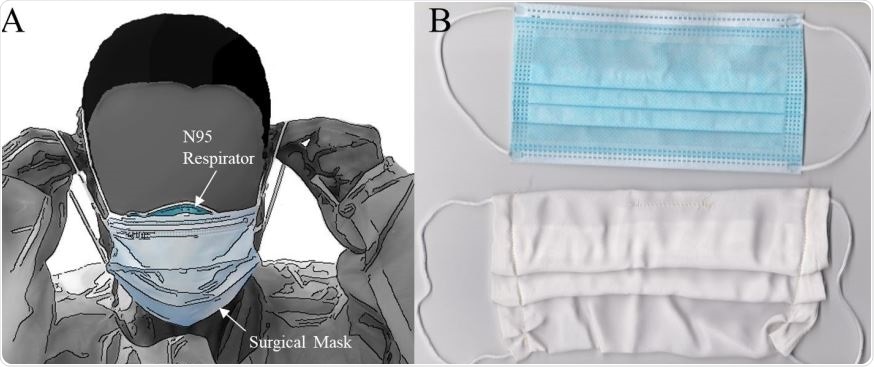Face masks for the general population and N95 respirators as part of personal protective equipment (PPE) for healthcare professionals are both a vital part of protection against viral transmission during the current COVID-19 pandemic. However, both are in short supply, and the scarcity is unlikely to be made up in the near future, primarily since both are intended to be disposable.
As many people are resorting to face coverings improvised from common fabrics, researchers from the University of Cincinnati looked to determine what fabrics were the most effective. The team examined the hydrophobicity of fabrics (silk, cotton, polyester), as measured by their resistance to the penetration of small and aerosolized water droplets, an important transmission avenue for the virus causing COVID-19. Their research is published on the preprint server medRxiv*, prior to peer review.
COVID-19 and Face Coverings
COVID-19 has caused over 10 million infections and more than 500,000 deaths in under seven months. The absence of any antiviral drugs for either preventive or therapeutic use has led to the widespread adoption of mandatory lockdowns, as well as physical distancing during social interactions, the use of face masks, careful and diligent hand sanitization and sheltering at home. The primary use of a face mask is to prevent the spread of information from the user to others, but some protection does occur in the reverse direction as well.

Reuse of Disposable Face Protection

 This news article was a review of a preliminary scientific report that had not undergone peer-review at the time of publication. Since its initial publication, the scientific report has now been peer reviewed and accepted for publication in a Scientific Journal. Links to the preliminary and peer-reviewed reports are available in the Sources section at the bottom of this article. View Sources
This news article was a review of a preliminary scientific report that had not undergone peer-review at the time of publication. Since its initial publication, the scientific report has now been peer reviewed and accepted for publication in a Scientific Journal. Links to the preliminary and peer-reviewed reports are available in the Sources section at the bottom of this article. View Sources
In some settings, the supply of PPE is so low that essential workers or healthcare workers are given only one respirator, which must be reused as long as they work, under high-exposure conditions, since there is no guarantee as to when the next mask will be provided. Faced with the shortage of single-use medical-grade respirators and face masks, and of surgical masks for common use, people have resorted to using any available material to make their own masks, either for stand-alone use or, in the case of healthcare workers, as a mask on top of a respirator.
This is not a method that can be used for prolonged periods since the number of layers makes it too thick to allow proper breathing, as well as trapping humidity near the face of the user, which increases viral spread. On the other hand, using less efficient masks reduces the protection level, leaving the user vulnerable.
PPE respirators are currently being sterilized so that they can be reused, but this process does result in a significant reduction in the ability of these respirators to block viral aerosols. Sometimes the sterilization process damages the equipment or makes it unfit for further safe use.
The Study: Which Material is Most Hydrophobic?
The current study reports on the utility of silk as the material for face coverings which conform to public health guidelines, and as part of PPE to increase its life and effectiveness. Cotton is a fabric that may seem suitable for this purpose, but in reality, there is not much information on how to choose the right material to make a comfortable, wearable, and reusable face covering.
The researchers examined five different materials: natural silk (from the cocoons of the silkworm, Bombyx mori, or the Robin moth (Hyalophora cecropia); processed 100% mulberry silk from pillowcases (washed and unwashed to examine the effect of conventional cleaning techniques), processed cotton, synthetic polyester and paper towel as a positive control.

Bombyx mori silk worm. Image Credit: Sarintra Chimphoolsuk / Shutterstock
Materials chosen were readily available, silk, polyester, and cotton. For one, they looked at the hydrophobicity of these fabrics, a property measured by the degree of resistance to the penetration of small water droplets, or aerosols of water, since this is an important route of transmission for severe acute respiratory syndrome coronavirus 2 (SARS-CoV-2).
Secondly, they looked at how breathable the fabric was, which determines how comfortable it is on prolonged use.
And thirdly, they assessed the resistance of the fabric to water, or sustained hydrophobicity, despite repeated cleaning.
The fabrics were tested both when used as an overlay over another barrier, or when used as a self-made face covering. They were tested individually for greater contact angles, signifying greater hydrophobicity, and the rate of gas exchange (breathability), as well as the saturation propensity of an individual droplet. They examined the ability of single and multiple layers of silk for saturation.
Aerosolization was used to test the penetration of a spray of droplets through the material, and also penetration of an aerosolized spray after five rounds of sterilization in a dry-heat oven.
The Benefits of Silk
They found that materials had significant differences in contact angles and, therefore, hydrophobic character. Silk had contact angles at or above 90 degrees, but the other three being hydrophilic, contact angles below 90 degrees, or immediately absorbing the droplets.
Silk is a material obtained from the silk moth, a natural fiber used to spin its cocoon. The protein material called silk is not only hydrophobic and resistant to the entry of water but also antimicrobial, antiviral, and antibacterial because of the presence of copper, incorporated by animals into their silk. It is used to make surgical sutures. Moreover, its use as a biomaterial for many healthcare applications is being researched.
Earlier studies showed that silk could be used as an antimicrobial barrier mask, with better filtration when multiple layers are used.
Saturation propensity was much higher with cotton and paper towels compared to silk, and the thicker the material, the larger the droplet area. With either double or triple layers of silk, the droplet penetration was significantly reduced by the same extent, compared to the single layer. This is important as people generally wear single or double-layered face coverings.
Gas exchange or porosity was highest for B. mori cocoons and cotton fiber, but less for silk and synthetic materials.
Silk Most Effective as Face Covering
The researchers found that when used for protection of the face, silk is the most effective at preventing the penetration of droplets, and the least absorptive of water, because of its intensely hydrophobic character compared to the other fabrics tested. In short, the face coverings made of 100% washed silk repelled water just as effectively as masks, but are hydrophobic, unlike the latter, and can be made ready for immediate reuse by sterilization.
This characteristic, coupled with its breathability, and the fact that it does not trap water, makes it ideal for protecting respirators under conditions of clinical exposure, and as a material for home-made for face coverings. The other advantages include its inherent antiviral, antibacterial and antimicrobial properties, as well as the thinness of the material even when used in multiple layers.
Silk also does not irritate the skin or increase local humidity around the face beneath it, making it suitable for prolonged wear, and avoiding accidental stimulation of face touching. Thus, this material, say the researchers, “may play a major role in the development of new PPE equipment, such as respirator inserts, that capitalize on its many benefits.”
The authors sum up: “In summary, we suggest that silk has untapped potential for use during the current shortage of PPE in the ongoing COVID-19 pandemic. It can be effective when used as a covering to extend the lifetime of N95 respirators, when fashioned as face coverings for the general public, and as a material for the development of the next generation of PPE.”

 This news article was a review of a preliminary scientific report that had not undergone peer-review at the time of publication. Since its initial publication, the scientific report has now been peer reviewed and accepted for publication in a Scientific Journal. Links to the preliminary and peer-reviewed reports are available in the Sources section at the bottom of this article. View Sources
This news article was a review of a preliminary scientific report that had not undergone peer-review at the time of publication. Since its initial publication, the scientific report has now been peer reviewed and accepted for publication in a Scientific Journal. Links to the preliminary and peer-reviewed reports are available in the Sources section at the bottom of this article. View Sources
Article Revisions
- Feb 23 2023 - The preprint preliminary research paper that this article was based upon was accepted for publication in a peer-reviewed Scientific Journal. This article was edited accordingly to include a link to the final peer-reviewed paper, now shown in the sources section.